L's Garden Checkpoint 7, 13 weeks later --
After another lovely trip on Amtrak to L's place, I found her garden getting ready for winter. Her jasmine sambac (double-petaled) is doing well, still blooming regularly even as the days get colder.
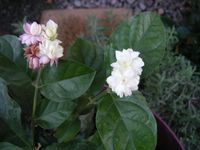
L's profusely flowering jasmine sambac
Several weeks back L scattered grass seeds and fertilizer over E's backyard lawn, and now the results are showing. You can see the new grass is slightly lighter than the old growth. It looks, however, like E's lawn hasn't been cut for a week.

E's recovering lawn -- new growth lighter green
L's container eggplants are doing okay -- healthy leaves with a few white flies and aphids, but any existing eggplant fruits are tiny.
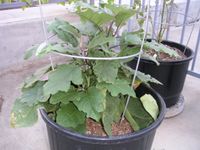
L's first container eggplant
This eggplant has more fruits (6+) currently growing.
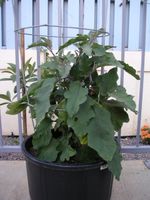
L's second container eggplant
The largest fruits, while a nice vivid purple, are still less than 4" long from calyx to blossom end.
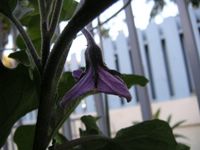
Pingtung eggplant flower
If only we had started the eggplants from seed a month or so earlier! We think the miniaturization issue, since the fruit are normally supposed to be 8" to 12" long, is due to our late start.
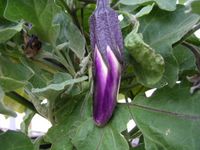
Pingtung eggplant fruit, larger one
Well, at least the eggplants have done better than the tomatoes in terms of resisting disease.
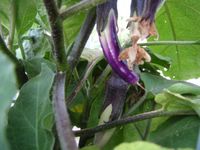
Pingtung eggplant fruits, clustered together near main eggplant stem
It's a real shame the fruit are so small, since they really look just like good grocery eggplant, just 1/4 to 1/2 the size.
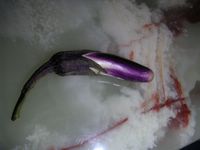
Picked pingtung eggplant fruit, 3" from calyx to blossom end
L's passiflora edulis is still hanging on, but the leaves have all lightened to a yellow-green. We're not sure if this is due to overfertilization or underfertilization.
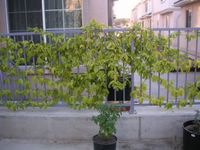
Yellowing passiflora edulis plant
As for L's tomatoes, they are all close to being tossed.
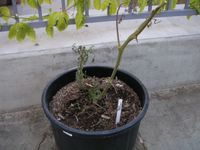
Dying Black Seaman heirloom tomato plant
L just really didn't have the time to maintain the plants and watch out for diseases and pests.
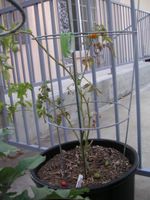
Dying Principe Borghese tomato plant
All the plants have lossed their lower foliage, though that is due to L removing all the brown and withered foliage and stems to prevent transferring disease to other parts of the plants.
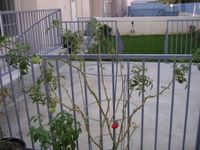
Dying Omar's Lebanese heirloom tomato plant
None of L's container tomatoes grew very big. The largest was probably the size of a medium-sized plum.
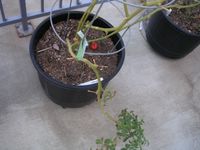
Dying Carmello tomato plant
L's best producer was the hybrid cherry tomato plant "Sweet Millions." Even now it has more healthy foliage than the others, though the birds seem to be getting to its fruit.
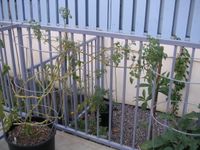
Dying Sweet Millions hybrid cherry tomato plant (left)
L's bird pepper "bush" is still going on strong. The season is winding down, though, so maybe in a few weeks the peppers will have all been picked.

?Chiltepin? peppers, or some other kind of bird pepper
L has several of these reddish-brown flying insects in her guava tree and perched among the leaves of her p. edulis. One person said they were mosquito hawks and thus good insects, but another said they might be crane flys, which in their larval stage are bad since at that stage they might eat plant roots. Can anyone tell me definitively what it is?
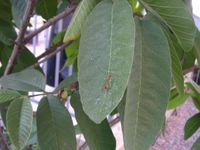
Crane fly?, perched on Strawberry guava tree leaf
L's guava trees are finally producing fruit, but it remains to be seen whether they will mature before winter sets in.
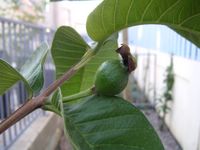
Tiny Strawberry Guava fruit
Gardenias seem to do well in the poor soil around L's and E's house. The only problem is the numerous slugs that live among them. I always jump a little when I pick a blossom to bring indoors and out pops a plump slug.
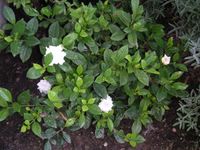
L's blooming gardenia jasminoides (veitchii)
The volunteer morning glory that came from over the wall seems to be growing a little more vigorously now. Probably that will change soon since it is an annual vine, but for now we find it blooming regularly.
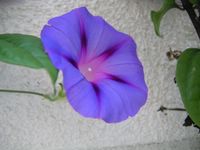
Volunteer morning glory blossom
As for the plumerias we finally rooted from cuttings just a month or so ago, nothing much is happening since the days are getting cooler. Every few weeks a new leaf seems to grow in.

E's backyard plumeria
Of all the phyllostachys nigra bamboo plants I bought online, the regular Phyllostachys Nigra (black bamboo) that was planted in front of E's front door seems to be the least vigorous of them all. There are still no new culms or shoots peeping up out of the soil.
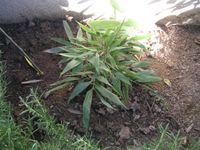
E's phyllostachys nigra bamboo, still no new culms or shoots since purchase
L's black bamboo, 'Hale,' in her lawn area seems to have grown a new culm, but it is very thin and weak looking. Recall that earlier the plant had set out 2 thicker culms.
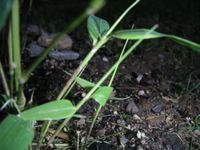
L's phyllostachys nigra 'hale' bamboo, new growth (center left)
The black bamboo thriving the best is the phyllostachys nigra 'bory' that was planted along L's house downstairs. There's another thick culm with a multitude of leaves shooting up out of the soil.
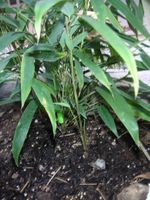
L's phyllostachys nigra 'bory', new young culm, closer to front


0 Comments:
Post a Comment
<< Home